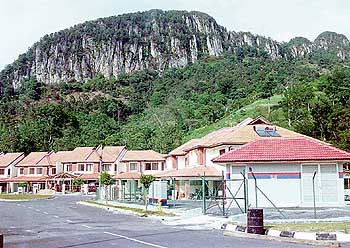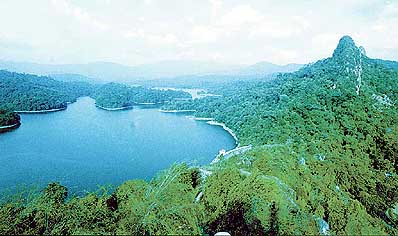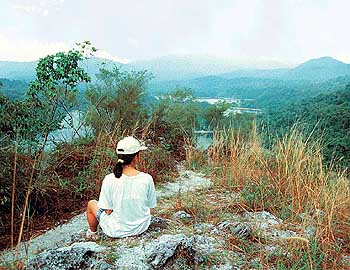Tuesday, April 14, 1998
Environment
The giant that needs protection
By Tan Cheng Li
ITS presence is imposing, to say the least: an immense block of craggy rock which rears up majestically from the ground. Built almost entirely of quartz, geologists marvel at its make-up for no other quartz outcrop in the country — perhaps even the world — can match its massive length and breadth. Biologists are no less impressed by this botanical treasure which nurtures some 265 plant species.
And yet, the Klang Gates Ridge gets scant respect from the public. Campers build fires which scar it and threaten to engulf its plants. Hikers chip off specimens of clear quartz crystal and foul the ridge-top with their discards. Fruit orchards and rubber plantations continuously creep up its slopes, obliterating its original vegetation. And burgeoning residential areas are closing in.

The Klang Gates' proximity to Kuala Lumpur makes the area surrounding the ridge a choice residential location. This project was temporarily stopped - but residents have moved in and there are plans for more development
But the biggest threat so far appears in the Ampang Jaya structure plan for 1995 to 2020 — new residential and industrial sites will be built on whatever little land there is left on the foothills of the ridge.
Much of the targeted area is tree-covered land surrounding the National Zoo as well as forests next to the Klang Gates Dam catchment area and the Ulu Gombak Forest Reserve (see map).
Why the Ampang Jaya municipal council (which governs the districts of Hulu Klang, Ampang and part of Setapak) chose the site is understandable. It is a choice residential location, being the last vestiges of prime land just outside city boundaries. Residents there also attest to the scenic views — especially on a haze-free day — of the towering ridge, flanked by the rolling hills of the Main Range in the distance.
Located within the district of Hulu Klang, the Klang Gates Ridge is divided into the east and west portions at its mid-point, which is also where the Klang Gates Dam and the Puncak Niaga water treatment plant are located.
Just outside the plant is the access point to the ridge top. Weekend hikers often take the short path which winds up the slope to the summit.

The western ridge looking to the east with the northern face and its dam
While visitors marvel at the views, the ridge's botanical treasures go unnoticed and unappreciated, laments plant taxonomist Dr Wong Khoon Meng.
"The ridge is what botanists call an island habitat. Isolated from the surrounding forest by the ridge, the vegetation at the top differs greatly from that of surrounding areas and boasts a diversity all its own."
The ridge's craggy face and sparse vegetation may look stark but, in reality, it houses an astonishing variety of plants. Flora surveys dating from the 20s reveal at least 265 plant species thriving there.
Of these, five are endemic. That is, they are not found anywhere else. Which is why conservationists fear for the future of the plants.
Since early this century, botanists have been urging that the ridge be protected. But it was only in 1935 that 128ha was turned into a wildlife reserve, mainly to protect the mountain goat, Serow. An additonal 0.8ha was added the following year.
Still, the "wildlife reserve" status has done little to shelter the ridge. Most of the foothills were parcelled out as Malay reserve land, including those surrounding the Klang Gates reservoir. Under a Selangor agriculture department scheme, the land was cultivated with banana, pineapple, durian and rubber.
The impact of human intrusion is evident. The ridge vegetation has been drastically altered in some parts, according to Dr Wong who is associate professor of the Institute of Biological Sciences at Universiti Malaya.
Stripped of the original hill dipterocarp forest, he says the southern face of the ridge (which faces the city) has become exposed. Without a shady tree canopy to retain moisture and tree biomass to provide organic matter to support other plants, the vegetation deteriorates over time.
"The south face now hosts less plants than the north face, which is still tree-covered because it forms the Klang Gates Dam catchment area and is next to the Ulu Gombak Forest Reserve.
"You only see scruffy, hardy plants on the south face unlike on the north face where plants are more diverse."
One of Dr Wong's graduate students, Zahid Mat Said, in a recent survey for his thesis found the endemic plant Aleisanthia rupestris only in undisturbed sites. Razed sites which had been colonised by weeds and ferns do not have the plant, which is the most common of the ridge's five endemic plants.
Dr Wong says the endemic grass, Eulalia milsumii, is no longer found on the west ridge where the slopes have been largely cultivated. Recent surveys of the east ridge also failed to locate the plant in areas where they were once recorded.
"These species have adapted to this environment and are narrowly distributed. Disturbing the habitat is likely to lead to extinction," warns Dr Wong.
Needless to say, the Ampang Jaya municipal council's development plans have triggered great alarm among botanists. Dr Wong, particularly, fears for the area south-east of the east ridge, behind the National Zoo.
Rarely visited because it is less accessible, this portion of the ridge is still in good condition, but the proposed development will be detrimental to it because the vegetation now sheltering it will be lost, says Dr Wong: "The east ridge should not suffer the same fate as some parts of the west ridge."
As some of the original vegetation in the area is already lost, Dr Wong foresees the council using that to justify its plans. While this may be true, he counters, "The existing fruit and rubber trees have stabilised by now, and should be kept that way. Let's not have another round of clearing."
What's going to happen?
Information on the proposed development is still scanty. How close will it be to the ridge? What type of development is it? The map in the structure plan is conceptual and provides little information. The plan merely states that existing orchards will be retained, and that any industrial development will be "non-polluting, high-tech, and service-oriented." Requests for an interview with council officials have yielded no response as yet.
Ironically, the plan states that the proposed housing and industrial zone, together with existing agriculture land, will act as a buffer zone for the wildlife reserve and dam.
Scientists beg to differ. They say what the ridge and the Ulu Gombak Forest Reserve need, in fact, is a tract of intact forest to buffer them from advancing houses, factories and farmland — in short, from human activity.
Allowing human activity too near means allowing access and then there would be no way of keeping encroachment in check. For instance, in the past, fires lit to prepare the land for planting had spread to the ridge-top, according to plant taxonomist Dr Ruth Kiew. Even recently, farmers at the eastern end of the ridge at Sungai Kemensah were seen torching the land.
Dr Kiew writes in a report that not all plants regenerate after a fire. Moreover, she says, the blazes change the ridge-top environment. Shaded areas once covered in thick moss become open, exposing the thin peat soil to rain, and invasion by weedy species.
"Every year, lallang creeps further up the slopes and brings the fire closer. Almost all endemic species are vulnerable to this fire risk," she writes.
Allowing development to envelop the ridge will further isolate the reserve from surrounding forests which stretch to the Main Range, says Worldwide Fund for Nature research officer Balu Perumal. He says this will restrict animal movements.
It also means that the beleaguered National Zoo will be further hemmed in. Balu points out that the adjacent Sungai Kemensah area slated for housing in the structure plan is the same one earmarked for the controversial Lost Horizon project in 1991.
The project — which was to include a golf course, condominiums, bungalows and shophouses — was shelved when zoo authorities protested. The Environmental Impact Assessment had also projected damage to flora and fauna in the area, especially in the wildlife reserve.
"Now, we are seeing a revival of a similar project," says Balu.
He warns that the catchment area of Sungai Kemensah will be at risk. The river, a popular weekend picnic spot, runs through the zoo, providing it with water, before feeding Sungai Klang.
The only agency with an influence over the area, the National Parks and Wildlife Department (Perhilitan), has yet to be consulted.
"If development is outside our area, the state need not inform us. They need to do so only if it is within our reserve," says E. Sivananthan, of Perhilitan's research and conservation unit.
However, no one knows exactly where the wildlife reserve boundary lies. So whether or not fruit orchards or residential houses have encroached into the reserve is uncertain; while wildlife officers have caught poachers for trapping Serow, they have not nabbed any party for encroachment.
Many believe that the wildlife reserve covers only the quartz outcrop but not the immediate habitat. Yet the surrounding vegetation is vital to protect the ridge habitat, as Dr Wong has pointed out.
Sivananthan insists that only with the boundaries demarcated can the area be properly managed. He does not foresee an easy task, however, because of the steep terrain and the cost of a proper survey.
Moreover, Perhilitan does not consider the ridge a priority area. Unlike other reserves, it is not known to be rich in fauna, apart from the Serow.
The department's last survey, in 1985, found the tracks of five Serow, a rare animal confined to few habitats. No one knows how many exist today. Sivananthan says one animal strayed onto a construction site a year ago, while a Serow poacher was caught two years ago.
Clearly, the "wildlife reserve" status of the ridge and whether it serves its function is in question. "Now, the sanctuary is just lying there. We do not know of Perhilitan's plans," says WWF's Balu.
He urges for more active management of the reserve, as well as reafforestation of slopes.
With many agreeing that a wildlife reserve is insufficient to secure a future for the ridge, conservationists want a state park created. They say the ridge is valuable not only in terms of botanical or geological interest, but also in terms of amenities.
"It is something truly special to have such a natural attraction so near the Klang Valley. It is accessible for education and recreation and, so, should be conserved as a park. It deserves to be better managed for everybody," says Christa Hashim, director of conservation group Treat Every Environment Special (Trees).
Trees and the Malaysian Nature Society (MNS) have proposed a state park which covers the wildlife reserve, the Klang Gates Reservoir and the Ulu Gombak and Ampang Forest Reserves.
Geological engineer Dr Ibrahim Komoo, who also plans to submit a plan for a park to the state government, says deterioration can be prevented if people appreciate the area. The Universiti Kebangsaan Malaysia professor envisions a recreation site much like the famed Garden of the Gods in Colorado, the United States. The quartz outcrop there has been turned into a park with walking trails through the foothills.
Like other concerned parties, Dr Ibrahim says the park must cover the complete ecosystem — meaning the ridge and surrounding forest. To prevent tourism from desecrating the place, he says a proper management plan is badly needed. Otherwise, visitors may foul the place with their discards or threaten rare plants with their campfires — which is what is happening now.

The much trodden path which winds to the top of the Klang Gates ridge shows signs of human disturbance
Dr Wong adds that proper development of the park would mean not just shelters, but walking trails with informative signage, since most visitors now are unaware of the area's flora wealth.
Similarly, Dr Ibrahim sees the ridge as a great venue for "geo-tourism," where people can learn about the geological features of the place.
Right now, the heritage of the ridge is clearly not appreciated. The ridge does not even appear in tourist brochures. Unless declared a protected area — either as a national monument or a state park — the quartz ridge and its endemic plants will be at the mercy of developers.
Another article on the QUARTZ RIDGE dated March 2004
Copyright belongs to the STAR